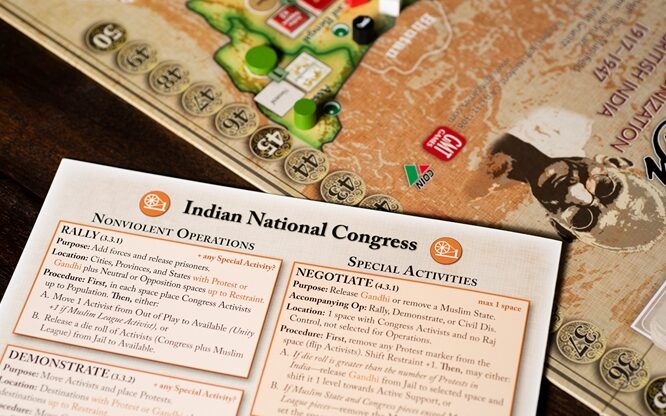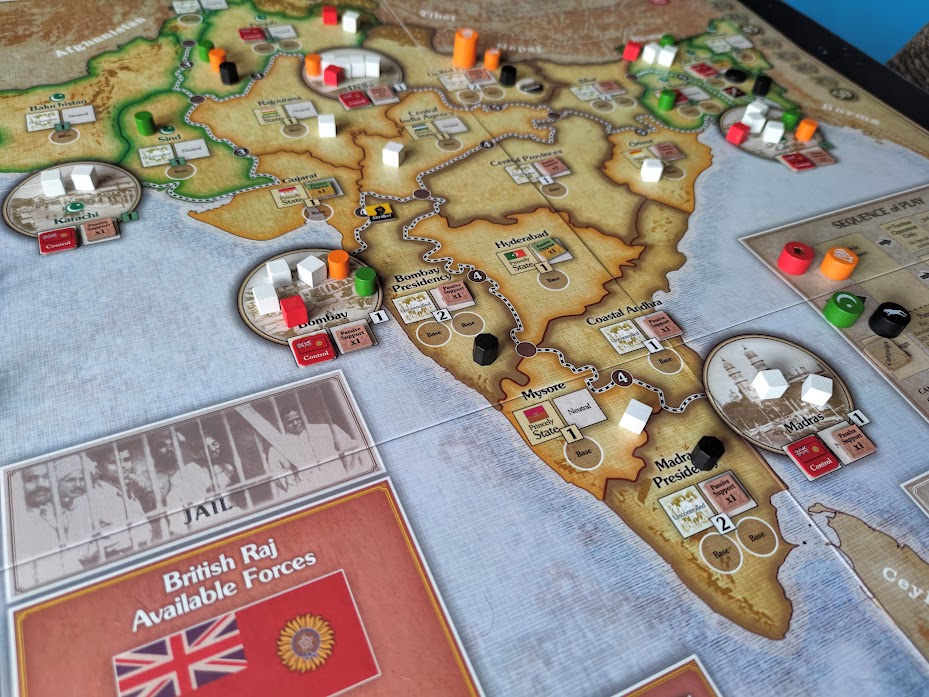My first foray into the world of proper wargames is with the game with the longest title in my collection. Gandhi: The Decolonization of British India 1917-1947, to give it it’s full name, is an asymmetric game from the undisputed masters of the modern wargame, GMT Games. It’s also the ninth game in a series from them called COIN. The name comes from the COunter-INsurgency style of action they represent.
Before I get into the guts of this review, I want to give a brief disclaimer. I’m coming at this game from the point of view of a real dyed-in-the-wool Euro game fan. My sole exposure to wargames had been Root up until now. Make of that what you will.
In at the deep end
The first thing that struck me when I started reading the rulebooks, is the incredible amount of depth the game goes into. The historical research, explanations of the events through the final decades of the British Raj, and the attention to detail is amazing. It’s something you don’t really need in the sort of game I normally play. “You’re a gnome in a fantasy world where stuff happens” is enough for a game like Bonfire. It very quickly became apparent how absolutely crucial this historical accuracy (as far as possible) is in the context of the game.

Deep is good word to describe the gameplay too. Taking turns in Gandhi is mechanically a really simple process, but you better believe you’re not going to be taking your turn in a few seconds. There is so much to consider with every single turn of the event cards, to the extent that the game includes marker pawns to plan your turn with. You use them to mark potential provinces to take actions in, because you’ll run through so many scenarios in your head, it’s easy to forget what you were planning.
That level of depth, and the weight of complexity, presents a big barrier. It’s a barrier that’s probably too big to overcome for some people. It’s easily the most complex game I own, but it’s also one of the best. The difficulty isn’t the result of poorly-written rules, or questionable gameplay mechanisms. It’s complicated because there is so much going on, and so many considerations to make.
In control
Each of the four different factions in Gandhi has its own different objectives and win conditions, but all of them have a vested interest in who controls the provinces on the map. The back and forth of this control is what the entire game is built upon. Control of India is based on two main concepts: the number of units and bases present in a province, and the level of support for the various factions in those provinces. Managing both is a real balancing act, and it’s what makes Gandhi so enjoyable to play.
The central mechanism that rules the flow of the game is a turn order track on the top of each event card, and it’s genius. Players queue up to take actions, just like any other game, but the kicker is that only two of them get a chance to play each turn. If you perform actions in the current round you are unable to perform any in the next. You have to sit the round out, which leads to some agonising decisions to make.

The player at the head of the queue looks at the current event card, and the one coming up, and has to make some really difficult decisions. The first player to perform an action determines the action the second player can take, as the two are linked on a chart on the board. How beneficial is the upcoming event to me, or to my opponents? Is it worth taking a sub-par standard operation for my faction, forcing the next player’s hand? You’ll tear your hair out trying to figure out the best option, and you’ll love every second of it.
Variations on a theme
As a Euro game fan, theme isn’t always the biggest of my concerns. The way the theme and setting are integrated in Gandhi, however, is something special. The whole game is so closely tied to its historical setting, and designer Bruce Mansfield has created something remarkable. The way he’s managed to create four asymmetric factions – two of them non-violent – and balance them so well, is nothing short of witchcraft.

The non-violent (NV) factions are really important too, as they offer a way to play a genre of game that is so often dominated with opposing military forces duking it out. It shows there’s another way to do a war game, and opens avenues into these games for those who find gamifying war to be off-putting.
The operations at your disposal are so different across the factions, and the victory conditions so diverse. It makes the game feel immensely replayable, but it means you really need an understanding of each of them if you want to stand even an outside chance of winning. This is common with nearly all asymmetric games – it comes with the territory – but it’s especially true in Gandhi, such is the weight and complexity of the game.
Required reading
The first time I set Gandhi up on my table, I sat down and read the rulebook. Afterwards, I didn’t have a clue what to do. I sat there staring blankly at the board. Then, I read it again, and I still wasn’t sure. To say Gandhi is a dense game to get into, would be an understatement. I’m aware that this is probably a result of it being my first exposure to a COIN game, but it’s something to bear in mind if it’s likely to be yours too.
Initially I felt disheartened, so I watched a ‘how to play’ video, which helped, but I still felt a little lost. Then I had a proper read of the second book in the box, the Playbook, and things got a lot better. Included in that book is a full tutorial for a shorter, four faction game, and it’s the best tutorial I’ve ever used. It walks through a number of turns of a game, and explains – conversationally – what’s going on at every step, and importantly why each player is doing what they’re doing.
Once you get through that initial density, the game clicks, and then the rulebook shines. It’s indexed and cross-referenced throughout, and you’ll find you only reach for it for setup and rules references. The player aids included are excellent, and all you need to play the game.
Solo play
Gandhi features a non-player (i.e. AI, Automa) deck for each of the four factions, and the system is called Arjuna. When you’re playing with four players, these decks can stand in for the missing players, but more importantly, it also means you can play solo.

I’ve played with a lot of different solo systems, and Arjuna is one of the best I’ve used. The cards use a simple true/false flowchart system which makes them really easy to use. There’s still a lot of checking conditions as you go, but in a game designed to be played slowly, with campaigns spanning hours, this isn’t as big a deal as it might sound.
When you consider how complex Gandhi is, to be able to boil the priorities and decisions down to a small number of cards and a chart is very impressive. It’s a really good solo experience, and I recommend it to anyone looking for a solo wargame.
Final thoughts
This has been the most difficult review I’ve had to write so far. I felt a little out of my depth taking on a GMT game with a BGG weight of over 4, and as a matter of pride, I didn’t want to do a poor job of reviewing a genre of game I have so little experience of. Trying to encapsulate the feeling of playing this game and squash it down into 1,500 words is no easy job.
Gandhi is a dense, heavy game, and it’s absolutely not for everyone. However, if you like a game with depth, with difficult decisions to make, and with beautifully balanced asymmetry, then it’s a game for you. It’s a game you’ll love. Each time I’ve played has felt very different, and had plenty of twists and turns, and it feels like a game I won’t get tired of playing. Coming at it from the point of view as a Euro gamer helped, and to be honest with you, the process of playing a game like Gandhi isn’t that far removed from other area control games you might know.
The biggest surprise to me wasn’t that I enjoyed the game, but just how much I enjoyed it. Gandhi: The Decolonization of British India 1917-1947 is one of the best games I’ve ever played. It’s still early days, but I think it might be my favourite game. That’s not something I say lightly either. It took a long time for me to write that sentence and make sure I meant it. Gandhi is outstanding.
Review copy kindly provided by GMT Games. Thoughts and opinions are my own.

Gandhi: The Decolonization of British India 1917-1947 (2019)
Designer: Bruce Mansfield
Publisher: GMT Games
Art: Knut Grünitz, Charles Kibler, Rodger B. MacGowan, Mark Simonitch
Players: 1-4
Playing time: 90-240 mins
